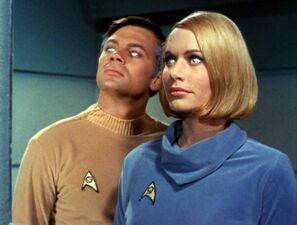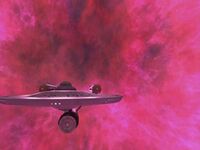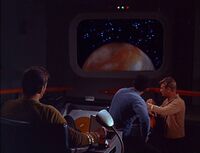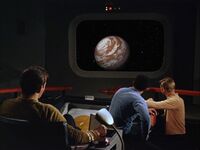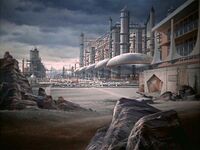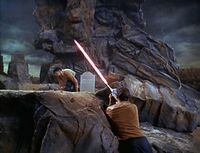Where No Man Has Gone Before (episode)/background information
| Real-World |
| “Where No Man Has Gone Before” | |||||
|---|---|---|---|---|---|
| Star Trek: The Original Series Episode | |||||
| In-Universe Details | |||||
| Stardate | 1312.4 | ||||
| Date | 11 May 2265 (Terran) | ||||
| Location | USS Enterprise | ||||
| Planet | Delta Vega I | ||||
| System | Delta Vega | ||||
| Sector | Delta Vega | ||||
| Quadrant | Alpha | ||||
| Background Information | |||||
| Production | |||||
| Written by | Samuel A. Peeples | ||||
| Directed by | James Goldstone | ||||
| Produced by | Gene Roddenberry Robert H. Justman (AP) | ||||
| Episode | TOS: 1x1 | ||||
| Production No. | 6149-02 | ||||
| Date aired | 22 September 1966 | ||||
| Chronology | |||||
| |||||
| |||||
| |||||
| Main Article | |||||
"Where No Man Has Gone Before" is the third episode of the first season of the American science fiction television series, Star Trek. Written by Samuel A. Peeples and directed by James Goldstone, it first aired on September 22, 1966.
The episode was the second pilot, produced in 1965 after the first pilot, "The Cage", was rejected by NBC. Reportedly, Lucille Ball, who owned Desilu Productions (where the pilot was produced), persuaded NBC management to consider a second pilot, thereby exercising a special option agreement it had with Desilu, because she liked Gene Roddenberry and believed in the project. The episode was eventually broadcast third in sequence, and it was the first episode to be shown in the United Kingdom by the BBC on July 12, 1969.[1]
"Where No Man Has Gone Before" was the first episode of Star Trek to feature William Shatner as Captain James Kirk, James Doohan as Chief Engineer Montgomery Scott, and George Takei as Lt. Sulu (in this episode, the ship's physicist, whose character became helmsman in subsequent episodes). The episode title is the final phrase in the opening voice-over[1] which characterizes the series and has entered popular culture.
The second pilot[edit | edit source]
- This was the second Star Trek pilot. However, it aired as the third regular series episode, after “The Man Trap” and “Charlie X”. In their book Inside Star Trek: The Real Story, Robert H. Justman and Herbert F. Solow explain that because this segment was "too expository" in nature – a common fault with pilots – it would not have made a good premiere episode for the series.
- Although NBC rejected “The Cage”, they felt that the series concept was strong enough to give Star Trek a second chance, despite having already spent an exorbitant US$630,000 on the first pilot. The network ordered three scripts, from which they would choose one to be developed into an unprecedented second pilot. The three scripts were “The Omega Glory” by Gene Roddenberry, “Mudd's Women” by Roddenberry and Stephen Kandel, and "Where No Man Has Gone Before" by Samuel A. Peeples. The advantage of "The Omega Glory" was that it showcased Roddenberry's "parallel worlds" concept and could be filmed using existing studio sets on the back lot as well as stock wardrobes. "Mudd's Women" was mainly a shipboard tale and could also be shot using the existing Enterprise sets left over from "The Cage". In addition, both required a minimum of new outer space effects shots. However, "Mudd's Women" guest starred "an intergalactic pimp", selling women throughout the galaxy, exactly what NBC didn't want, and "The Omega Glory" wasn't very good. The network finally chose "Where No Man Has Gone Before" which, although it required many new special effects, sets, props, and costumes, was the most powerful and compelling of the three scripts.[2]
- There is a different, pre-broadcast cut of this episode in the archives of the Smithsonian Institution. This unique cut includes a few brief scenes trimmed from the aired cut of the episode, different opening titles, and a unique opening and closing theme. The alternate themes can be heard on the GNP Crescendo CD Star Trek: Original Series (Volume 1) "The Cage" / "Where No Man Has Gone Before". This version was the one screened as the second pilot to NBC executives in the tail-end of 1965, and was originally available in bootleg form only, screened at numerous conventions, before becoming available commercially on the TOS Season 3 Blu-ray set.</ref>[http://www.thrfeed.com/neverbeforeseen-star-trek-pilot-found.html</ref> James Doohan was credited as "Engineer", Paul Fix as "Ship's Doctor", George Takei as "Physicist", and Paul Carr as "Navigator" in the end credits of the original cut. It was in effect the Institution itself which had already recognized the cultural significance of Roddenberry's creation; in a rare move – considering the highly contemporary nature of a television series of such recent date – the Institution invited Roddenberry in 1967 to submit both pilots and assorted production material, such as still photography, scripts and story outlines, for safekeeping for posterity. This the consummate (self)promoter Roddenberry did in a formal presentation at the Institution, pursuant the conclusion of the series' first season.[3]
- A second different title sequence resulted from the fact that the main responsible visual effects director, Darrell Anderson of effects company Howard Anderson Company, suffered a third nervous breakdown, brought on by the stress he was under to deliver the new opticals in time and on budget, as Justman recalled when he and Roddenberry came calling in August 1966 on the status of the Enterprise footage for the title sequence, as the series was slated to start its run on 8 September with "Where No Man" scheduled to air third, "We had seen maybe six good shots and some others that were partially usable. We had expected many more angles, some of which were badly needed for our series main title. "Where's all the other shots, Darrell?" Darrell began to shake. He jumped to his feet, screaming, "You'll never make your first airdate." Bursting into tears, he ran out of the room, still screaming, "You'll never make your first airdate! You'll never make your first airdate!" Gene sat there in shock. I raced after Darrell and caught him outside. He was weeping. And no wonder. We later found out he had been working both day and night for months, trying to satisfy our needs. That afternoon, Darrell went to Palm Springs for a rest cure." Roddenberry and Justman managed to compose a title sequence from the footage already shot, the same day.[4] This was the version as originally aired by NBC on 22 September 1966. The more sophisticated final title sequence was produced (with Anderson returned to his duties) for subsequent episode airings and replacing the improvised sequence for those episodes where it was utilized in reruns. Incidentally, Darrell Anderson suffered his second nervous breakdown while working on the second pilot the year previously, from which he needed two weeks to recover.[5]
- The aired version of this episode features a different version of the first season opening credits, which does not have William Shatner's opening narration, and uses a different orchestration of the main and end title themes. These orchestrations were used until mid-season during the original run and the initial syndication showings. However, in the 1980s, Paramount withdrew the prints from syndication and redistributed remastered and pre-cut episodes with standardized opening and closing credit music for the first season (using the Fred Steiner arrangement created for the back half of the season). These remastered prints were also used, in their uncut form, for the video and laserdisc releases. Only this episode was permitted to keep the original Alexander Courage arrangement. The 1999 DVD volumes, and later season sets, however, restored the opening credits to their original form, while leaving the end credits in their altered state (again, except for this episode which remains as originally aired).
- The original narration spoken by Shatner was:
- "Enterprise log, Captain James Kirk commanding. We are leaving that vast cloud of stars and planets which we call our galaxy. Behind us, Earth, Mars, Venus, even our Sun, are specks of dust. The question: What is out there in the black void beyond? Until now our mission has been that of space law regulation, contact with Earth colonies and investigation of alien life. But now, a new task: A probe out into where no man has gone before."
- After NBC saw this episode, they were pleased with the results and decided that Star Trek would be a weekly television series. Gene Roddenberry said that, like “The Cage”, "Where No Man Has Gone Before" still had a lot of science fiction elements in it, but that it was the bare knuckle fist fight between Kirk and the god-like Gary Mitchell that sold NBC on Star Trek.</ref>The Star Trek Saga: From One Generation To The Next</ref>
- This was the first episode of Star Trek to be shown by the BBC in the UK when the series premiered on 12 July 1969.
Story and script[edit | edit source]
- TNG adopted a gender-neutral and species-neutral version of this episode's title for TNG: "Where No One Has Gone Before".
- This episode sets the original series record for Enterprise crew members killed: twelve (Mitchell, Dehner, Kelso, and the nine who Spock says died when crossing the galactic barrier).
- Kirk says he's been worried about Mitchell "ever since that night on Deneb IV." Coincidentally (or not), TNG's pilot episode “Encounter at Farpoint” takes place on Deneb IV, home of the Bandi.
- Gary Mitchell states that the "Nightingale Woman" poem was written in 1996 and that it is one of the "most passionate love sonnets of the past couple of centuries". Taken literally, this line of dialogue seems to suggest that "Where No Man Has Gone Before" takes place no later than the end of the twenty-second century, which in turn would imply that the Valiant was launched during the twentieth.
- In reality, the poem ("My love has wings…") was written by Gene Roddenberry about his World War II airplane.
Production[edit | edit source]
- Bob Justman anticipated that the second pilot would take nine days to shoot. However, after "The Cage" went severely over schedule and budget, Desilu's "old guard" executives worried about the same situation regarding the second pilot. To avoid these fears, "Where No Man Has Gone Before" was scheduled to be filmed in seven days. The "old guards" skeptically expected that it will take ten or even eleven days. Filming began on Monday, 19 July 1965. As expected, filming the pilot went over schedule, finally resulting in eight days and an extra day of shooting pickup shots and "inserts" – nine days, exactly as Justman expected.[6]
- Just as "The Cage", the second pilot was filmed at Desilu's Culver City studios. For the series itself, the entire production was moved to Desilu's main Gower Street facilities in Hollywood.[7]
- On the fifth day of filming, Friday, 23 July 1965, a swarm of bees attacked the set, causing delay in filming, and injuries to William Shatner and Sally Kellerman, who were both stung by the bees.[8]
- During the syndication run of Star Trek, no syndication cuts were made to this episode.
Sets and props[edit | edit source]
- The gravestone Mitchell creates for Kirk reads "James R. Kirk". According to D.C. Fontana in the introduction for Star Trek: The Classic Episodes 1, when the mistake was discovered, Gene Roddenberry decided that if pressed for an answer on the discrepancy, the response was to be "Gary Mitchell had godlike powers, but at base he was Human. He made a mistake." The gravestone also suggests that an important event marked "C" took place on stardate 1277.1; Kirk may have assumed command of the Enterprise on this stardate.
- The mountainous backdrop painting from "The Cage" is reused in this episode.
- In this episode, the helm console from the bridge was moved to the transporter set to double as the transporter console. Thus, the three levers used to "energize" are not yet in place.
- When he complies with Kirk's order to "Address intercraft," i.e. put open the intercom, Mitchell merely wipes the edge of his hand over his navigation plotting board and does not manipulate any buttons or switches.
- A bit of the transporter chamber was changed from "The Cage." The center of the ceiling was "hollowed out," allowing white light to pour down onto the platform when the "materializer" was not in operation. After this episode, however, the dark, grilled ceiling from "The Cage" was restored and remained in place throughout the series.
- The phaser rifle that Kirk uses appears for the first and only time in the series. However, it can be seen on many pre-season 1 promotional photos. It was designed and created by Reuben Klamer, who, being subcontracted, received no credit for it.[9]
- In this episode, the sickbay walls are green.
- The alert light on the helm console is of a different shape in this episode.
- A large panel seen in the background of the Delta Vega control room was recycled as part of the main engineering set in the series itself.
- Spock carries a laser pistol (somewhat modified) as first seen in "The Cage".
- This episode features the goose-neck tubes also used in "The Cage".
- The communicator Kirk uses at the episode's end to hail the Enterprise is the Lucite-encased, circuit board-filled version from "The Cage".
- The insignias for the Sciences and Engineering divisions were opposite in this episode of what they were in every other episode.
Effects[edit | edit source]
- The matte painting of the lithium cracking station was created by matte artist Albert Whitlock for this episode. A still exists showing the entire landing party in the doorway within the matte, but only the shot of Kirk and Dehner ended up being used. The matte painting was later altered and reused in “Dagger of the Mind”. The image of the matte painting later appeared on the March 1953 issue of the Incredible Tales magazine in the Star Trek: Deep Space Nine episode “Far Beyond the Stars”.
- Film trickery enabled Kirk, Spock, and Mitchell's elevator ride to look like an actual ride from one deck to another, without relying on editing. When Mitchell jumped in, there was a gray wall outside the door that hid the bridge set. When the doors closed, the wall was removed by the stage crew, and then seconds later, they're on the bridge. The turbolift in the background after this scene sports "double doors" like modern elevators – the inner one is gray and the outer is red. This feature survived into “The Corbomite Maneuver” and at least until “Tomorrow is Yesterday”, but then was phased out.
- When Kirk, Spock, and Mitchell emerge from the turbolift, the main viewscreen can be seen in its "off" setting – a kind of "psychedelic" visual effect that was never used again.
- The voices of damage control personnel responding to the emergency situation were reused many times in subsequent episodes. These voices were provided by Gene Roddenberry, Robert Justman, Majel Barrett, Herb Solow, and other production staff members, including some from Mission: Impossible. Roddenberry can be heard saying, "Communicator, we need more lines to the impulse deck!" in subsequent episodes.[10]
- Except for the shot of the Enterprise leaving the Barrier – which was shot using the three-foot unlighted model – all other ship fly-bys were produced using the eleven-foot model used in all subsequent episodes. At the time, this model still had no sparkling effects on the front of the nacelles. It also had a larger sensor dish, grilles on the backs of the nacelles, and not as many lighting effects. This footage was re-used in later episodes, often mixed in with shots of the improved model that is on display in the Smithsonian Air and Space Museum. In the standard side-to-side fly-by, two lights on the angled pylon (which connect the two hulls) go out, followed one second later by two near the shuttlebay.
- The original "bridge zoom-in" Enterprise shot from the beginning of "The Cage" is reused from stock footage in this episode, making it the only shot from the original pilot to appear in the second one.
- The same shot is also used when the Enterprise hits the barrier with added purple background and lightning effects.
- Stock footage of the Enterprise in the barrier was reused in “By Any Other Name” and “Is There in Truth No Beauty?”. These are the only three original series episodes in which the Enterprise leaves the galaxy.
Preview[edit | edit source]
- The preview contains a Captain's Log recorded solely for the preview: "Captain's log, stardate 1312.4. The next mission of the Enterprise takes us into an unknown force field which affects the destiny of my closest friend."
Reception[edit | edit source]
- A print of the pre-broadcast version of this episode was taken by Roddenberry to the annual World Science Fiction Convention in Cleveland, Ohio to be presented to the convention goers. This marked Star Trek's second showing to the general public, on 4 September 1966 with Harlan Ellison having premiered a color print of one of the unaired episodes (those in attendance give conflicting reports on exactly which one of the early episodes was shown) earlier at the San Diego Westercon 19 the previous July.[11] Allan Asherman, author of The Star Trek Compendium, was present among the audience. He recalled, "There must have been 500 people in that audience. When the Enterprise hit the galactic barrier, 1,000 eyes opened wide. Five hundred respiratory rates accelerated with that wonderful pleasure that comes over lovers of all things when they see their favorite subject being treated well. (…) If he [Roddenberry] could have read our minds at any moment during the screening, he would have been the happiest producer in the world. (…) Here was a future it did not hurt to imagine. Here was a constructive tomorrow for mankind, emphasizing exploration and expansion. This was a science fiction television series we all wanted to see. We were extremely impressed. (…) In fact, we liked everything about the episode more than anything else shown at the convention. (…) Roddenberry seemed to have no idea of the effect his show was having on us. (…) He asked for the audience's opinion; we gave him a standing ovation. He smiled, and we returned the smile before we converged him. We came close to lifting the man upon our shoulders and carrying him out of the room."[12]
- Later, a group of the audience asked Roddenberry if he had brought any other episodes of Star Trek with him. He had a black-and-white copy of "The Cage", which was then screened to the audience.[13]
- Herb Solow commented on Gene's success: ""Where No Man," unlike the other television and theatrical films screened, was well received. The science-fiction aficionados at the convention were entranced by the new show. But in four days, the series would premiere on television to a national audience that thought science fiction was comic books of busty women being dragged away by alligator people, or a giant purple blob intent on dissolving Tokyo."[14]
- Bjo Trimble and her husband, John, were members of the audience at the convention, and it was the first time they'd met Roddenberry. They persuaded him to allow the Star Trek costumes he brought along to be displayed during the fan-made costume competition.[15]
- Isaac Asimov was also a member of the audience. At the start, Roddenberry shushed a loud man to be silent, not knowing that the man was actually Asimov. [1] When Roddenberry found out it was Asimov, he was horrified.[16]
- Roddenberry picked this as one of his ten favorite episodes for the franchise's 25th anniversary. (TV Guide August 31, 1991)
- Jason Isaacs also cited this as one of his favorite Star Trek episodes, remarking that he "loved" it. Regarding the transformation to god-like status that happens to Gary Mitchell and Elizabeth Dehner in this episode, Isaacs joked, "I tried for years to do that. In fact, I still try sometimes, in quiet moments."[17]
Apocrypha[edit | edit source]
- An alternate explanation for the "James R. Kirk" reference is given in Peter David's novel Q-Squared, which suggests that the events of this episode take place in a parallel universe where Kirk's middle initial is indeed R (and not T as we now know it to be). This same book suggests that Gary Mitchell's god-like powers were a result of him being temporarily possessed by Q, and the powers simply drove Mitchell insane.
- Another explanation for the R as Kirk's middle initial comes from Michael Jan Friedman's three-part novel series, My Brother's Keeper. In it, Kirk claims his middle name to be "Racquetball" to Mitchell upon an early meeting. Later, Mitchell "changes" it to "Rhinoceros" after Kirk steamrolls through a conversation. The grave is thus explained by Kirk as an in-joke.
- Mandala Productions' Fotonovel #2, in its cast of characters section, identified the captain for this episode as "James R. Kirk", even though all the other Star Trek Fotonovels listed him as "James T. Kirk".
- The alternate reality's version of events in this episode were depicted in issue 1 and issue 2 of IDW Publishing's ongoing Star Trek comic book. In this version, only Mitchell is affected – Dehner was a former lover of Dr. McCoy, and after the affair ended badly, their relationship was so strained that she rescinded her requested transfer to the USS Enterprise (NCC-1701 alternate reality) after finding out he was on board. Also, while Mitchell was in sickbay, Spock mind melded with him and reported to Kirk that he found "No consciousness. No sentience of any kind."
- The Pocket TNG novel The Valiant acts as a prequel and sequel to this episode, telling the story of the SS Valiant's demise and reveals that some of the crew did survive the self-destruction.
Remastered information[edit | edit source]
- The remastered version of this episode premiered in syndication the weekend of 20 January 2007 and featured shots of a digital version of Enterprise, consistent with the model used in this episode, which had a slightly different appearance from both the version seen in the production of the series and that seen the original pilot, “The Cage”. Enhanced effects also included more detailed shots of the barrier, Delta Vega from space as well as on the surface, a subtle touch-up to a phaser shot during Kirk and Mitchell's fight, and an opening titles sequence featuring the pilot-version Enterprise.
- While the final frontier speech was absent from the original, it was brought into the remastered opening.
- The next remastered episode to air was “For the World is Hollow and I Have Touched the Sky”.
Production timeline[edit | edit source]
- Episode commissioned by NBC: 26 March 1965
- Story outline by Samuel Peeples: first week of April 1965
- Revised story outline: second week of April 1965
- First draft teleplay by Peeples: late-April 1965
- Revised first draft teleplay: 27 May 1965
- Second draft teleplay by Gene Roddenberry: 16 June 1965
- Final draft teleplay: 26 June 1965
- Revised final draft teleplay: 8 July 1965
- Additional revisions: 12 July 1965, 14 July 1965, 15 July 1965
- Filmed: 19 July 1965 – 29 July 1965
- Score recorded: 29 November 1965
- Original airdate: 22 September 1966
- Rerun date: 20 April 1967
- First UK airdate 12 July 1969
- Remastered airdate: 20 January 2007
Video and DVD releases[edit | edit source]
- Original US Betamax/VHS release: 28 February 1985
- Original UK VHS release (two-episode tapes, CIC Video): Volume 2, catalog number VHR 2210, release date unknown
- As part of the UK Star Trek - The Three Beginnings VHS collection: 31 January 1994
- US VHS release: 15 April 1994
- As part of the UK Star Trek - The Four Beginnings VHS collection: release date unknown
- UK re-release (three-episode tapes, CIC Video): Volume 1.1, 24 June 1996
- Original US DVD release (single-disc): Volume 1, 17 August 1999
- As part of the TOS Season 1 DVD collection
- As part of the TOS Season 1 HD DVD collection
- As part of the TOS Season 1 Blu-ray collection
- As part of the TOS Season 3 Blu-ray collection, entitled "Where No Fan Has Gone Before" – The Restored, Unaired Alternate Pilot Episode
- As part of the Star Trek: The Original Series - Origins Blu-ray collection
- View online at the CBS website (available in the US only)
Cast[edit | edit source]
- It was the first appearance for Trek mainstays Kirk, Sulu, Scott, and Leslie. Other regulars McCoy and Uhura did not appear until the next episode. In Star Trek III: The Search for Spock, Uhura is said to be a twenty year space veteran as of 2285, suggesting that she began her career sometime before, after, or during this episode.
- Leonard Nimoy (Spock) is the only actor to appear in both this episode and the first pilot, “The Cage”. His pointed ears are a bit smaller than in the first pilot, and his eyebrows are severely slanted (yet not as bushy as in "The Cage"). Most importantly, his hairstyle is reworked to show the bangs typical of his race – and that of eventual nemeses, the Romulans.
- William Shatner was actually the third actor to be considered for the role of James T. Kirk. Jack Lord and Lloyd Bridges were each offered the role before him.[18]
- Veteran character actor Paul Fix got the role of the ship's doctor, replacing John Hoyt. Gene Roddenberry wanted to cast DeForest Kelley in the part, whom he originally wanted to play Doctor Boyce in “The Cage”. Then, he was overruled by director Robert Butler's suggestion. Here again, Fix was recommended by director James Goldstone. Roddenberry thought Fix didn't work out well in the role, and decided that if Star Trek became a weekly series, he would cast Kelley as the ship's doctor.[19]
- Andrea Dromm replaced Laurel Goodwin in the role of the captain's yeoman. According to Herb Solow and Bob Justman, her role was actually a "non-part" and Roddenberry claimed he cast her so he could "score with her". They added, it was not just a "non-part", but a "non-score" as well.[20] Dromm didn't return to the series, and was replaced by Grace Lee Whitney as Yeoman Rand.
- Roddenberry, Solow, and NBC were all happy about the casting of Lloyd Haynes as communications officer Alden. Haynes was one of the first African-Americans hired to play an important role in a network series pilot. However, he was not rehired for the series itself, as the production staff saw the role as dull and uninteresting.[21]
- This is the only episode of the series in which James Doohan (Scott) appears but DeForest Kelley (McCoy) does not.
- This is the only episode where Spock and Scott wear gold and tan tunics instead of their better known blue and red, respectively.
Starring[edit | edit source]
Guest stars[edit | edit source]
Featuring[edit | edit source]
- George Takei as Sulu
- James Doohan as Scott
- Lloyd Haynes as Alden
- Andrea Dromm as Yeoman Smith
- And
Uncredited co-stars[edit | edit source]
- Eddie Paskey as Leslie
- Unknown actors as
Stunt doubles[edit | edit source]
- Dick Crockett as stunt double for William Shatner
- Hal Needham as stunt double for Gary Lockwood
Crew[edit | edit source]
Production crew[edit | edit source]
- Directed by James Goldstone
- Written by Samuel A. Peeples
- Created and Produced by Gene Roddenberry
- Associate Producer: Robert H. Justman
- Music Composed and Conducted by: Alexander Courage
- Director of Photography: Ernest Haller, ASC
- Production Designer: Walter M. Jefferies
- Art Director: Rolland M. Brooks
- Film Editor: John Foley, ACE
- Assistant Director: Robert H. Justman, Gregg Peters
- Casting: Joseph D'Agosta
- Set Decorator: Ross Dowd
- Costumes Created by: William Ware Theiss
- Sound Mixer: Cam McCulloch
- Post Production Executive: Bill Heath
- Music Editor: Jack Hunsaker
- Sound Editor: Joseph G. Sorokin
- Production Supervisor: James Paisley
- Wardrobe: Paul McCardle
- Special Effects: Bob Overbeck
- Music Consultant: Wilbur Hatch
- Music Coordinator: Julian Davidson
- Makeup Artist: Robert Dawn
- Hair Styles: Hazel Keats
- Matte Paintings: Albert Whitlock
- Sound: Glen Glenn Sound Co.
- Photographic Effects: Howard Anderson Co.
- Executive in Charge of Production: Herbert F. Solow
Production companies[edit | edit source]
References[edit | edit source]
- ^ a b Asherman, Allan (1987). The Star Trek Compendium. Titan Books. ISBN 0-907610-99-4.
- ^ Inside Star Trek: The Real Story, pp 65-66; The Star Trek Compendium, p 17
- ^ "Smithsonian Seeks TV Pilot", Los Angeles Times, 13 June 1967, p. C19
- ^ Inside Star Trek: The Real Story, p. 281
- ^ Cinefantastique, Vol. 27, No. 11/12, p. 69
- ^ Inside Star Trek: The Real Story, p 85
- ^ Inside Star Trek: The Real Story
- ^ Inside Star Trek: The Real Story, p 83
- ^ Julien's Auctions presents: Star Trek
- ^ Inside Star Trek: The Real Story, pp. 190-191
- ^ "What We Did On Our Visit To Desilu" by John & Bjo Trimble, ST-PHILE #1, Jan 1968, p. 33
- ^ The Star Trek Compendium, pp 2-3
- ^ The Star Trek Compendium, p 3
- ^ Inside Star Trek: The Real Story, p 263
- ^ Inside Star Trek: The Real Story, p 378
- ^ Inside Star Trek with Gene Roddenberry
- ^ CTV Sci-Fi Channel "The Cast of Star Trek: Discovery Tell Us Their Favourite Star Trek Episodes" on YouTube
- ^ The Star Trek Compendium
- ^ Inside Star Trek: The Real Story, pp 74-75, 152
- ^ Inside Star Trek: The Real Story, p 75
- ^ Inside Star Trek: The Real Story, p 75-77, 153
External links[edit | edit source]
- Where No Man Has Gone Before (episode) at Memory Alpha, the wiki for canon Star Trek.
- Where No Man Has Gone Before at Memory Beta, the wiki for licensed canon & non-canon Star Trek works.
- "Where No Man Has Gone Before" at StarTrek.com, the official Star Trek website
- Where No Man Has Gone Before at Wikipedia, the free Terran-based encyclopedia that anyone can edit.
- "Where No Man Has Gone Before" on IMDb
- "Where No Man Has Gone Before" at MissionLogPodcast.com, a Roddenberry Star Trek podcast
- Article on the episode at Orion Press
- Final revised draft script
| Previous episode produced: “The Cage” |
Season 1 |
Next episode produced: “The Corbomite Maneuver” |
| Previous episode aired: “Charlie X” |
Next episode aired: “The Naked Time” | |
| Previous remastered episode aired: “Wink of an Eye” |
TOS Remastered | Next remastered episode aired: “For the World is Hollow and I Have Touched the Sky” |
| Previous event: “The Magicks of Megas-Tu” |
Next event: “Mudd's Women” |

